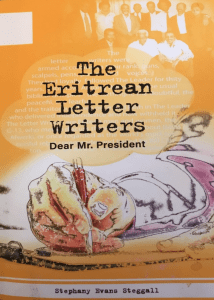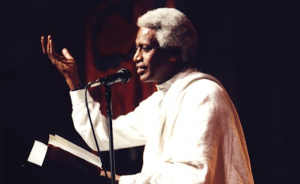The Letter Writers: ‘Dear Mr. President’
By Dr Stephany Evans Steggall
 ‘The Letter Writers’ is the story of the so called ‘Berlin Manifesto’. The manifesto was not only a critical letter that addressed grave issues that constrained the country during post-Badme war, it also changed the Eritrean political landscape for good because Eritreans, especially those living abroad, felt emboldened to criticise their ominous government at will.
‘The Letter Writers’ is the story of the so called ‘Berlin Manifesto’. The manifesto was not only a critical letter that addressed grave issues that constrained the country during post-Badme war, it also changed the Eritrean political landscape for good because Eritreans, especially those living abroad, felt emboldened to criticise their ominous government at will.
The book, which is written in a story format, featured the late Reesom Haile, the finest poet Eritrea had ever seen, as a protagonist in the account. In fact, the book is dedicated to his memory.
Reesom, more or less, provided sustenance to Dr Stephany E. Steggall, the author, from start to finish for she found him to be unique in his approach, style and intellect.
The Potsdam Meeting
On 1st of October 2000, 13 Eritrean academics and intellectuals met in Potsdam, Berlin, to discuss issues concerning their country that emerged out of the two-year war with Ethiopia (1998-2000) very much bruised.
The signatories of the ‘Berlin Manifesto’ were, in alphabetical order, Araya Debessay, Assefaw Tekeste, Bereket Habte Selassie, Dawit Mesfin, Haile Debas, Kassahun Checole, Khaled A. Beshir, Lula Ghebreyesus, Miriam M. Omar, Mohamed Kheir Omar, Mussie Misghina, Paulos Tesfagiorgis and Reesom Haile.
During the Potsdam meeting Reesom assumes centre stage in the story. He is a great story teller; contemplative, good natured, humorous and a bit eccentric. On the whole, he is poetry in motion as he catches and throws thoughts around. The author did a good job in scattering his poetry throughout the book showing his aura of intellectual authority.
After the letter was finalised by the group, it was DHL’ed to President Isaias on 3 Oct 2000. A copy was sent to Mr Semere Russom, the Eritrean ambassador in Washington, D. C.
“Reesom printed the letter out and sat for a long time considering the contents. Bereket had admirably combined all their concerns. It was long – a treatise rather than a letter. He had brought his legal expertise to bear to bear on the style. It was divided into eight segments, with an introduction and a conclusion.”
The letter the writers wrote at the end of their two day session started with the following introduction.
“Dear Mr. President:
We, the undersigned, Eritrean academics and professionals, concerned with the predicament facing our country, have agreed to meet in order to make a sober appraisal of our country’s current problems and to suggest appropriate solutions.”
As soon as the letter was despatched disaster struck. Somehow, the letter was leaked to Dehai, a pro-government news list, by someone with a fictitious name.
After the letter was made public, the situation turned hostile, problematic, difficult, and increasingly chaotic as the story unfolded. Simply stated, an intense exchange of angry emails began flying in every direction among Dehai members.
The element that shocked the diehard government supporters was the fact the ‘Letter Writers’ (dubbed the G13) did not ask the government for permission to gather and discuss matters of concern to them and the general public. As far as the government aficionados were concerned the G13’s protest letter was supercilious and arrogant; and an explicit consolation to the enemy.
For weeks, after the letter was made public, rival fans across the globe were engaged in a pitched media battle over the letter. As all hell broke loose during the boorish interactions, out of the blue the president wrote a letter to the Letter Writers, inviting them for a face-to-face meeting in Asmara.
The Asmara Meeting
It is fascinating to read how the author describes each and every member of the G13, especially their interactions in Asmara (Hotel Embasoira), their anxious but brave demeanours, how they began to gel and their thoughts crystallized well and more. Although they knew they were walking into the lion’s den, they stayed upright and stoic throughout their deliberations in Asmara.
 The best part of the story is to read how Reesom Haile, grows into an accomplished and charming person in the plot. He is pensive, philosophical, brave, intense but always quietly observant. And sometimes very funny.
The best part of the story is to read how Reesom Haile, grows into an accomplished and charming person in the plot. He is pensive, philosophical, brave, intense but always quietly observant. And sometimes very funny.
After ‘The Leader’ gave the visiting group a run-around, he finally sent them a message that he would meet them at 3:30 p.m. at Denden, the old Officers’ Club.
Well, 25 Nov 2000 was the day of reckoning for the group - whether they were ready or not, they had to confront The Leader.
When all members of the G13 assembled, The Leader walked in dressed casually and wearing sandals. “EnqwaE bdeHan meSa’kum – welcome”, he said.
Haile took this as his cue to start reading the group’s prepared statement.
“Your Excellency, Mr President, allow me first, on behalf of our group, to express our deep appreciation for inviting us to this face-to-face discussion of the issues we raised in our letter to you.”
As Haile read his letter, The Leader shifted in his seat but remained silent. He looked intently at each person as Haile introduced his friends by name and position, as if ‘framing their faces in a file’. Then Haile explained the meeting in Berlin and what the group had hoped to achieve.
Haile ploughed on as The Leader kept his stare on him. In the end, Haile concluded his speech by saying that “[the group] has a huge stake in the success of Eritrea. Glory to our martyrs!” The room was silent, everyone wondering what The Leader was going to say.
What followed was disappointment; history and poetic injustice. Reader should open the pages and read the story for themselves.
Thomas Keneally, the renowned Australian author, said the following about the book:
“This is a beautifully realised and written story about a group of thirteen Eritreans writing to their President, Isaias Afwerki, grieving for their country – once the most heroic, liberal and hopeful nation on earth. It is the story too of what befell them and others as a result. Stephany Evens Stegall provides a most poignant and humane lens with which to look at one of the greatest tragedies of humanity, the tragedy of the Horn of Africa.”
The book is published by DIO Press Inc, New York – https://www.diopress.com
The book is simply too expensive.
Framing their faces in file” echoes the behavior of the infamous Stalin, who butchered many of his comrades and millions of Soviet citizens. Ironically Thomas Keneally, the famous novelist, misses this incident in The Eritrean Letter Writers. Instead, he frames and laments the disappearance of “ once the most heroic, liberal and hopeful nation on earth.”